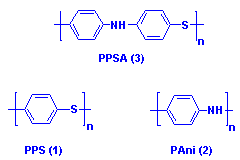 Intrinsically conducting polymers (ICPs) have been the subject
of study of many research groups all over the world due
to its scientific importance considering both, chemical
processes involved and potential technological applications.
Intrinsically conducting polymers (ICPs) have been the subject
of study of many research groups all over the world due
to its scientific importance considering both, chemical
processes involved and potential technological applications.
These new materials offer the possibility of combining the
intrinsic properties of plastics with the electric, magnetic
and optical behavior of metals and semiconductors. Intrinsically
conducting polymers change form insulators to conductors
by the reversible oxidation or reduction of their conjugated
system.
Many problems have to be overcome focusing the wide industrial
application of these materials, mainly, related to its instability
in air and difficult processing due to the fact that most
of them are insoluble in conventional solvents and infusible.
In this way, our studies aim to obtain co-polymers or blends
with good conducting and mechanical properties. The mixture
of polymers like polyaniline or polypyrrole with conventional
plastics, such as PVC or other rubbers, allows increasing
the processability of the ICPs and the preparation of conducting
polymeric blends with excellent mechanical properties. Even
today, industry continues its demand to new polymeric materials
for a wide rage of applications. In this filed, we have
prepared some polymers from bifunctional monomers that,
depending on the polymerization media, they produces different
materials.
 Frequently, the property searched
for one material is in the middle between the properties
of two other ones. The monomers of these two homopolymers
can take part of an unique macromolecule, named co-polymer,
leading to a new material that combines the main properties
of both homopolymers.
Frequently, the property searched
for one material is in the middle between the properties
of two other ones. The monomers of these two homopolymers
can take part of an unique macromolecule, named co-polymer,
leading to a new material that combines the main properties
of both homopolymers.
In our Laboratory, we have synthetized a new material poly(phenilene
sulfide-co-phenilenamine), PPSA (3), a copolymer of PPS
(1) and PANI (2). This new material presents both, very
interesting electrical properties and very good processability,
due to the introduction of amino groups in the main PPS
chain leading to lower crystallinity and higher solubility.